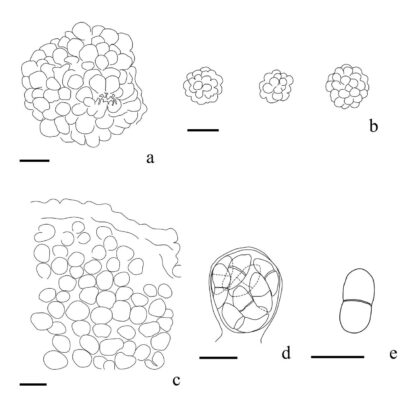Fungalpedia – Note 381, Etayoa
Etayoa Diederich & Ertz
Citation when using this data: Tibpromma et al. 2024 (in prep.) – Fungalpedia, Ascomycota.
Index Fungorum, Facesoffungi, MycoBank, GenBank, Fig. 1
Classification: Phaeococcomycetaceae, Lichenostigmatales, Arthoniomycetidae, Arthoniomycetes, Pezizomycotina, Ascomycota, Fungi
Based on the phylogenies of LSU and mtSSU analyses and morphological studies, Ertz et al. (2014) established Etayoa to accommodate the type species E. trypethelii (Phaeosporobolus trypethelii). Etayoa is characterized by dark brown to blackish stromata, subspherical to elongate, 8-spored asci, subspherical to shortly ellipsoid, hyaline ascospores, 1-septate, ellipsoid, with roundish apices; frequent conidiomata, absent conidiophores, pale to medium brown conidiogenous cells, shortly subcylindrical to almost ellipsoid, seceding with conidia, multicellular conidia, composed of conidiogenous cells and conidial cells; brown, subspherical, dry, single, verrucose, secession schizolytic, and conidial cells subspherical to ellipsoid (Ertz et al. 2014). No other species have been introduced to this genus, which remains monotypic.
Type species: Etayoa trypethelii (Flakus & Kukwa) Diederich & Ertz
Other accepted species: This genus is monotypic.
Figure 1 – Etayoa trypethelii. a Young conidioma showing mosaic-like ornamentation. b Conidia. c Ascostroma. d Ascus. e Ascospores. Scale bars: a-e = 10 µm. Redrawn from Ertz et al. (2014).
Reference
Entry by
Du TY, Center for Yunnan Plateau Biological Resources Protection and Utilization, College of Biological Resource and Food Engineering, Qujing Normal University, Qujing, Yunnan 655011, China; Center of Excellence in Fungal Research, Mae Fah Luang University, Chiang Rai 57100, Thailand; School of Science, Mae Fah Luang University, Chiang Rai 57100, Thailand.
(Edited by Saowaluck Tibpromma, Samaneh Chaharmiri-Dokhaharani, & Achala R. Rathnayaka)
Published online 25 November 2024
